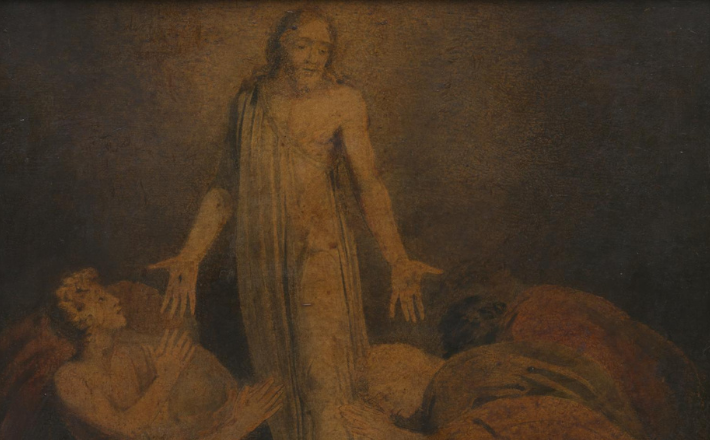Commentary on Acts 3:12-19
Peter’s speech in Acts 3:12–19 interprets the dramatic events that have just occurred; to understand the speech, we must look to the previous passage.
In 3:1–11, as Peter and John are entering the temple courts to pray, a man who was born lame asks them for money. Instead of giving him what he requests, Peter miraculously and completely heals the man in Jesus’ name, to the astonishment of those who witness it. In fact, four times Luke says the witnesses to this healing are astonished (3:10–12), further developing a well-established Lukan theme: in the Gospel, first, God “amazes” people (1:63; 2:18, 33), then Jesus does (4:22, 32, 36; 5:24-26), and now in Acts, the apostles take on this role.
The healing bolsters Peter’s authority, partly by connecting him with Jesus’ previous miraculous healing abilities (compare with Luke 7:22), and partly by recalling the prophetic tradition that at Israel’s redemption, those who are lame will “leap like a deer” (Isaiah 35.6). Yet, Peter is quick to impress upon his hearers that he healed the man through God’s power, not his own (3:12–13).
Recent advances in disability studies offer several important correctives to common readings of this passage. First, disability rights advocates caution against echoing biblical rhetoric that equates humans with their disabilities; for example, instead of “the lame man,” we can use phrases such as “the man who was born lame.” To some, this might seem unnecessarily cumbersome or like it’s merely semantics, but phrases like “the lame man,” “the paralytic,” or “the blind man” treat the person as though that physical condition is all they are, as though a bodily characteristic fully defines them.
Second, “disability” itself is a cultural construct; all humans are impaired to varying degrees and in varying ways. This does not diminish the very real circumstances (including ridicule, discrimination, and violence) experienced by folks with specific impairments, nor does it negate the need to advance God’s love by working for mercy, justice, and equity in the world.
Rather, it helps us acknowledge that no one should be defined solely by one attribute, physical or otherwise, and it allows for diversity in responses to those specific realities. Not every person who is blind, for instance, thinks or feels the same way about blindness; those with sight should not automatically assume that physical healing is desired. No one should assume they understand others’ experiences of what it means to be in the bodies they are in.
Third, biblical texts like this one frequently equate impairment with sin and impurity, and take bodily healing as a sign of divine blessing and forgiveness. Luke portrays the healing at the Beautiful Gate as the first instance of the “wonders and signs” prophesied in 2:43; afterward, even the apostles’ opponents (the Jewish council) wonder what to do about the apostles, “for through them, a notable sign has come to be, visible to all who live in Jerusalem, and we cannot deny it” (4:16).
Even if Peter saves his condemnatory language for his Jewish listeners, calling them, and not the man he has healed, to repentance (3:13-15), the healing is depicted as an undeniable sign of the apostles’ godliness and the truth of their message.
A subtle consequence of this is that the text pulls attention away from the man with the disability and toward the apostles. Where is our attention? Whom do we center in our preaching? Do we focus on those our society tends to marginalize and stereotype as powerless, or on the ones who claim God’s power? When might those not actually be separate at all? That is, when do those whose bodies are marginalized have a great deal to teach about God’s miraculous power?
Scholars debate whether, historically, actual laws banned those with disabilities from entering the Temple, but at least in Acts, the man only does so after he is healed. A key question, then, is whether this story demeans or emancipates those who have disabilities: Does Luke’s God overturn human discrimination and welcome all, regardless of appearances or abilities, into divine presence? Or is Luke subtly reinforcing ancient body-related polemics, implying that one must be physically able in order to be spiritually acceptable?
Peter’s speech does not answer these questions directly. It does, however, echo the one he gave at Pentecost (which is next week’s lectionary passage). Just as in Acts 2:1–21, Peter here addresses a misunderstanding and offers a new interpretation, clarifies a miracle’s divine origin, and demonstrates that Jesus fulfills messianic prophecies. How can Christian preachers today mirror these aspects of Peter’s speech, instead of the harmful ableist rhetoric we also find in this passage?



April 14, 2024